
















Grandpappy's Pemmican Recipe
A Native American Indian Survival Food
Copyright © January 2008 and February 10, 2009 by Robert Wayne Atkins, P.E.
All Rights Reserved.
 Pemmican is a Native American Indian survival food that has a very long shelf life and it requires no refrigeration. It is similar to a Granola Bar except it contains no artificial preservatives. It is a compact energy source that contains protein, fiber, fat, carbohydrates, natural fruit sugars, vitamins, and minerals. It also tastes great because it is a simple combination of meat jerky and your favorite dried fruit.
Pemmican is a Native American Indian survival food that has a very long shelf life and it requires no refrigeration. It is similar to a Granola Bar except it contains no artificial preservatives. It is a compact energy source that contains protein, fiber, fat, carbohydrates, natural fruit sugars, vitamins, and minerals. It also tastes great because it is a simple combination of meat jerky and your favorite dried fruit.
To make pemmican you only need three basic ingredients:
- lean meat,
- animal fat, and
- fruit or berries.
Pemmican has several very important and desirable characteristics:
- It uses both the lean meat and the fat from an animal.
- It conveniently stores your summer food harvest for winter consumption.
- It requires no refrigeration or canning jars for safe long-term food storage.
- It does not weigh very much because it contains no significant moisture.
- It is a complete meal all by itself.
- It is very nutritious and very tasty.
- It can easily be made in the wilderness without any special cookware or equipment.
The following recipe uses equal amounts of dried lean meat, dried fruit, and melted fat. However, pemmican is a very flexible food and you can vary the quantities of these three basic ingredients to more fully utilize almost all of whatever food you may have available. For example:
- Most animals have a lot of lean meat but very little fat. In this situation you should only use just enough melted fat to hold your pemmican together.
- Depending on the weather conditions the summer wild fruit and berry harvest may be excellent or very poor. Depending on what you actually have available each summer you could use more or less dried fruit or berries in the recipe.
- During the summer when wild game and berries are widely available you can harvest as much as you can and then process it all into pemmican for winter consumption when little or no food will be available. This is the reason pemmican was such an important survival food for the Native American Indians.
- If you have more lean meat than you can use, then you can simply convert the extra lean meat into meat jerky.
- If you have more dried fruit than you can use, then you can simply save the extra dried fruit for winter consumption.
- If you have very little animal fat, then it is possible to make a simple granola snack for winter consumption by mixing some dried meat and dried fruit together without using any melted animal fat. However, if you have animal fat then you should use it because animal fat is a necessary food for long-term survival.
Instructions for Making Pemmican
Basic Ingredients:
1 Cup of Dried Meat
1 Cup of Dried Fruit or Berries
1 Cup of Melted Animal Fat
 |
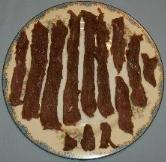 |
 |
 |
| Raw Beef | Trimmed & Sliced | Dried into Jerky | Dried Meat Powder |
Meat: Use deer, moose, caribou, or beef, but not pork. It takes between one to two pounds of fresh meat to make one cup of dried meat. The meat should be as lean as possible. Trim off all the fat. Cut the fresh meat into wafer thin slices about 1/4 inch thick or a little thinner.
Do not add salt at this time. Do not soak the meat in a solution of salt and water. This is not the best time to add salt when you are making pemmican. Salt should be added later in this recipe.
Use either one of the following two methods to process the fresh meat:
- If you have a meat grinder then grind the fresh meat twice. Spread the ground meat evenly on aluminum foil on a cookie sheet and dry inside an oven at 185 degrees Fahrenheit (85 degrees Celsius) for 3 to 5 hours, or until it is crisp and chewy. Stir the meat every hour. Don't cook the meat -- just dry it.
- If you don't have a meat grinder then spread the meat strips evenly and separately on aluminum foil on a cookie sheet and dry the sliced meat inside an oven at 185 degrees Fahrenheit (85 degrees Celsius) for 6 to 10 hours, or until it is crisp and chewy. Turn the meat strips over after two hours so they will dry evenly on both sides. You do not want to cook the meat. You only want to dry it. If the meat snaps or cracks when bent it is done. If it bends it still contains too much moisture. If it crumbles it is too dry but it can still be used.
Grind or crush the dried meat almost into a powder. If you have an electric blender then blend the meat into a fine pulp.
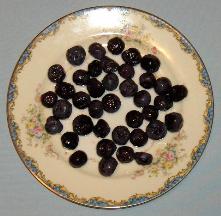 |
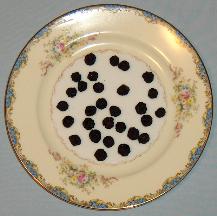 |
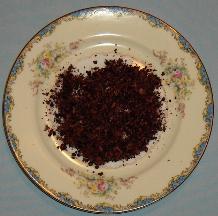 |
| A Few Fresh Blueberries | A Few Dried Blueberries | Dried Blueberry Powder |
Fruit or Berries: Use one or two types of fruit or berries, such as blueberries, huckleberries, currants, raisins, apples, apricots, or cherries. Cut the fruit into thin slices or pieces and allow them to dry in the sun. Or dry them in the oven at the same time you dry your meat jerky. Or use an electric food dehydrator. Grind the dried fruit into a powder but leave some of it a little lumpy to provide for extra texture and taste.
Mix the dried meat powder and the dried fruit powder together in a bowl. If you have an electric blender then add the dried fruit to the dried meat in the blender and mix them together.
Optional Salt: If you have salt, then you should stir some salt into the mixture to enhance its flavor. The addition of salt at this time will distribute the salt throughout the mixture which includes both the dried meat powder and the dried fruit powder so the salt can help to protect both ingredients. Salt will increase the shelf life of the pemmican and it will help to retard the future growth of harmful microorganisms that may try to attack the pemmican from the surrounding environment. The salt will not kill those microorganisms but it will help to keep them from multiplying. If you do not have any salt then you should keep your pemmican in a sealed glass jar, or a sealed food grade plastic storage container, or a sealed heavy-duty plastic freezer bag in order to help protect it from any harmful microorganisms that may be present in the surrounding air.
Optional Ingredients: Add a little honey. Or add some minced dried onion for flavor. Or add a few crushed nuts. However, nuts contain oil and the nuts will shorten the shelf life of your pemmican. When adding these optional ingredients you should begin with a very small batch of pemmican. This will permit you to experiment and determine if the results are agreeable to your family's taste requirements without ruining a huge batch of pemmican.
Optional Granola Snack: If you have nuts, such as acorns, then a better use for them would be to crush them and mix them with your extra left-over dried meat and dried fruit to make a granola type stack. Granola is easy to mix together if you have the ingredients and therefore it should not be prepared before you are ready to eat it. If you prepare it too soon and one of your ingredients goes bad then it will ruin all your granola. But if you wait until you are ready to eat it, then you can easily detect the bad ingredient and discard it and not put it into your granola mix.
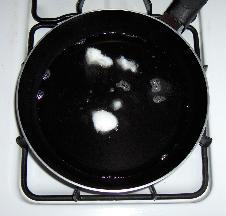 |
| Melting Pork Fat (Lard) |
Animal Fat: Use fresh beef fat or pork fat or bear fat. Animal fat will quickly become rancid and it should be melted (rendered) as soon as possible. Cut the fat into 1/8 inch or 1/4 inch cubes and melt it over medium-low heat in a very small amount of clean rainwater in a clean cook pot. Do not allow it to smoke. If it starts to smoke then you are burning the fat.
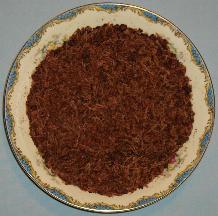 |
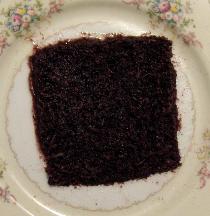 |
 | |
| Dried Meat & Berry Mix | Melted Fat Added | Finished Sliced Pemmican |
When the fat is completely melted gradually pour it over the meat-fruit mixture in the bowl and stir until the mixture is well coated and sticks together. Then spread it out like dough and allow it to cool completely. When cool cut it into pieces about 1 inch wide and 4 inches long.
Storage: If possible, wrap the pemmican in plastic wrap or store it in ziplock bags or in plastic storage containers with a tight fitting lid. Pemmican can be safely stored for 8 months. If you can keep the temperature between 40 to 75 degrees Fahrenheit (4 to 24 degrees Celsius) then pemmican can be stored for several years.
Salt Footnote: Salt does not kill or neutralize the harmful microorganisms that may be present in the meat or the fruit. Salt only inhibits their future growth. Any harmful microorganisms that might be present will be killed by the heat during the meat drying process, and during the fruit drying process, and during the fat melting process.
Optional "Brine" Solution of Salt and Water for Meat Jerky: If you have more lean meat than dried fruit then you could convert the extra lean meat into meat jerky. After slicing the meat into thin strips you could soak the meat strips in one-quart of water that contains 1/8 cup salt. Soak the sliced meat in the salt solution for 30 to 60 minutes, depending on the thickness of the meat strips. Stir the meat strips inside the salt solution every 15 minutes to achieve a good distribution of the salt mixture onto all the surfaces of the meat. Several pounds of fresh thin meat strips can be processed in the salt water solution at the same time. If your only objective is to preserve the meat then a salt brine soak is a very good idea because the salt water solution will saturate into the meat and help to protect it.
Salt and Pemmican: However, if you are making pemmican then you should not soak the meat in a salt brine solution. If you saturate the meat with salt then the meat will have a very salty taste and you will not be able to add more salt later. The reason salt should be added later is because it is better to equally distribute the salt throughout the entire pemmican mixture, including the dried meat, the dried fruit, and the melted animal fat. Therefore, if you are making pemmican then you should dry the meat and grind it into tiny pieces or a powder. Then dry the fruit and grind it into tiny pieces or a powder. Mix the meat and fruit together and then add some salt. The salt will be able to make contact with all the surfaces of the meat, and with the fruit, and later with the hot melted animal fat. This is the best way to add salt when making pemmican because the salt will help to protect the entire pemmican wafer bar instead of just protecting the meat inside the bar.
Technical Footnote: Neither sodium nitrite, nor sodium chloride (table salt), nor a brine solution will neutralize all the harmful microorganisms that could be present in fresh meat. In fact, the scientific experiment that was summarized at "lib.bioinfo.pl/pmid:952" in the year 2008 reported that sodium nitrate only slowed down the growth of Salmonella and Staphylococcus on hot dogs and, according to the scientists, sodium nitrite did not slow the growth rate of these harmful microorganisms by a significant amount.
On the other hand, it has been repeatedly documented that heat will kill almost every harmful microorganism that could normally be present in meat. For example, in beef, venison, and other red meats:
- Salmonella is killed at a temperature of 165 degrees Fahrenheit (74 degrees Celsius).
- Listeria monocytogenes is killed at a temperature of 160 degrees Fahrenheit (71 degrees Celsius).
- Staphylococcus aureus is killed at a temperature of 140 degrees Fahrenheit (60 degrees Celsius).
- Escherichia coli is killed at a temperature of 165 degrees Fahrenheit (74 degrees Celsius).
The reason for this technical footnote is to help clarify any misunderstanding that people may have about the importance of salt in comparison to heat for making meat safe for human consumption.

Personal Footnote: Occasionally I am asked about my dark complexion and whether or not I have any Native American Indian ancestors. The answer is yes. I have Cherokee American Indian ancestors. However the last one passed away in 1893. At this time all I have is her picture and our family traditions.
Grandpappy's e-mail address is: RobertWayneAtkins@hotmail.com




































 Pemmican is a Native American Indian survival food that has a very long shelf life and it requires no refrigeration. It is similar to a Granola Bar except it contains no artificial preservatives. It is a compact energy source that contains protein, fiber, fat, carbohydrates, natural fruit sugars, vitamins, and minerals. It also tastes great because it is a simple combination of meat jerky and your favorite dried fruit.
Pemmican is a Native American Indian survival food that has a very long shelf life and it requires no refrigeration. It is similar to a Granola Bar except it contains no artificial preservatives. It is a compact energy source that contains protein, fiber, fat, carbohydrates, natural fruit sugars, vitamins, and minerals. It also tastes great because it is a simple combination of meat jerky and your favorite dried fruit.












